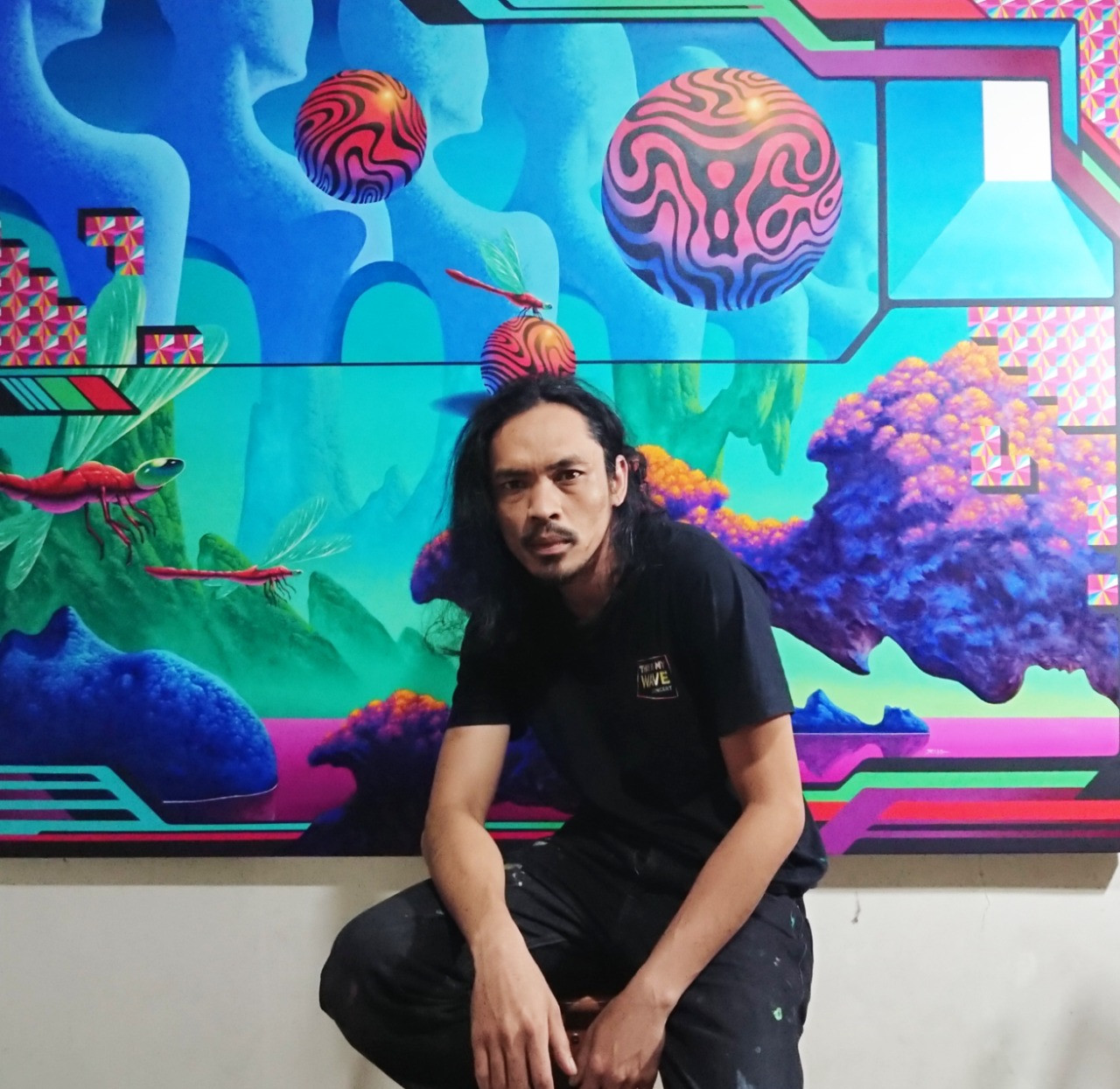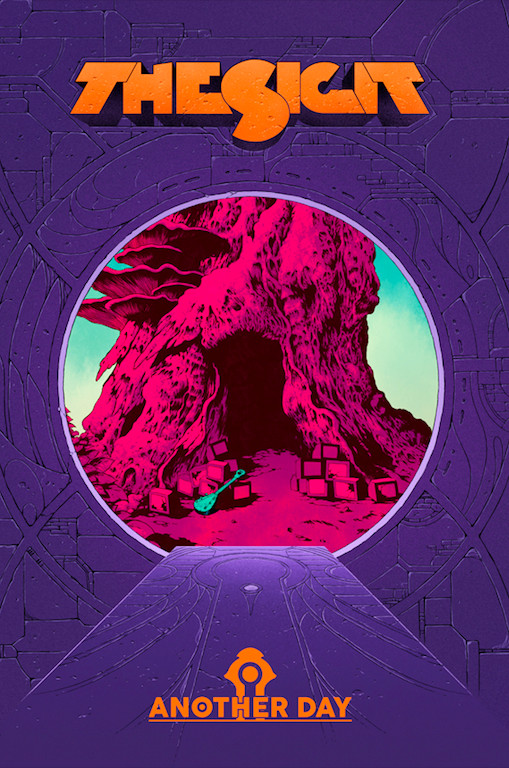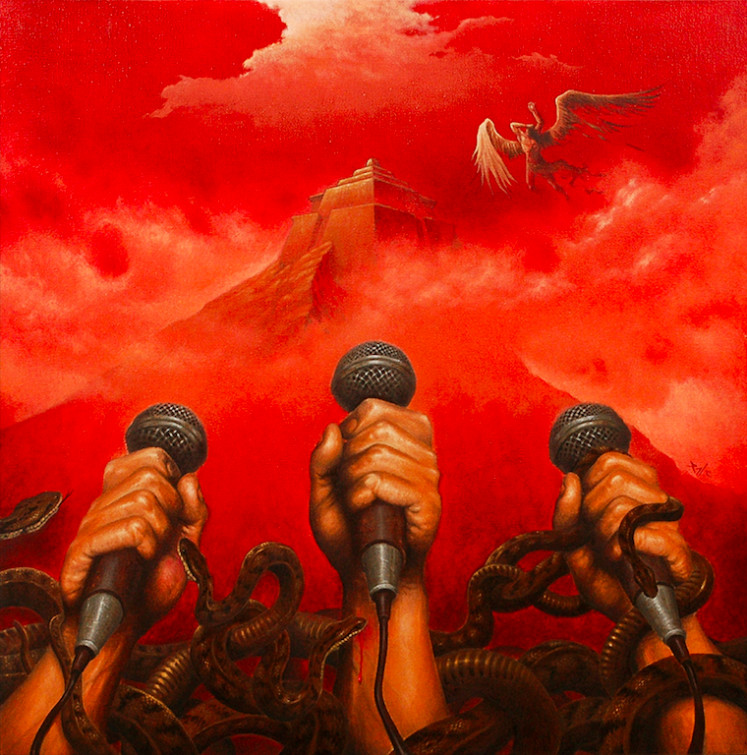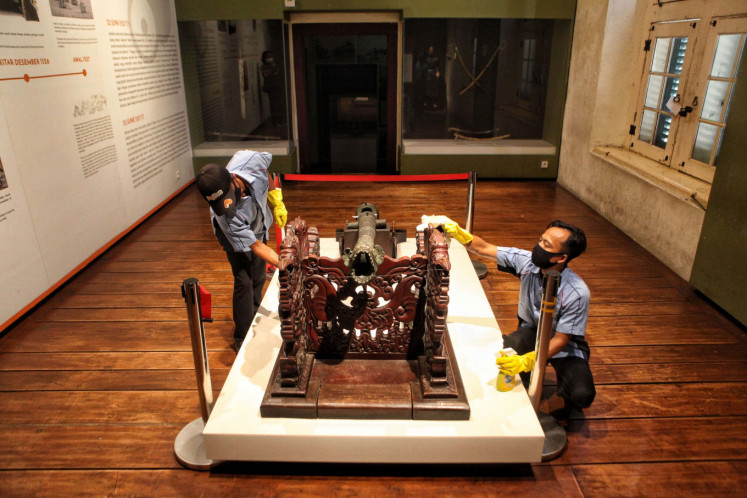Tapping into the unconscious: Riandy Karuniawan’s epic sci-fi illustrations
Combining his love for Japanese manga, surrealism and science fiction, Bandung-based artist Riandy Karuniawan has created a style of illustration that is both psychedelic and thought-provoking.
Change text size
Gift Premium Articles
to Anyone

C
ombining his love for Japanese manga, surrealism and science fiction, Bandung-based artist Riandy Karuniawan has created a style of illustration that is both psychedelic and thought-provoking.
Riandy does not like being the center of attention. Much like how Sathar — one character he created who later became a visual signature of his work — is only a part of the environment, Riandy uses his art to tackle universal themes: the human unconscious and the unknown.
Riandy’s sci-fi/fantasy landscapes can easily be found on the album covers and merchandise of Indonesian and global artists, from Bandung’s hard rockers The SIGIT to United States metalcore band Trivium.
Aceh-born Riandy moved to Bandung in West Java when he was 15. An avid fan of Japanese fantasy manga such as Dragon Ball, he has been into surrealism and the psychology of human minds since high school. He then discovered the work of Spanish avant-garde artist Salvador Dali, which inspired him to discover the foundation of his own style.
“Dali’s paintings deal with the psychological and the metaphysical, and that made me think: ‘Oh, I can express myself about the things I feel, and not just see?’” Riandy recounted. “Before, I was just copying from comic books, but then I dug deeper, and surrealism became the best medium for me to express myself.”

Heart on sleeves
Hanging around a lot of rock and metal musicians in Bandung, he was often asked to make illustrations for them.
Being a die-hard fan of the stoner metal heavyweight Komunal, Riandy offered his art to the band, which was later used as a merchandise design before the band asked him to work on its album cover. In 2012, Riandy’s illustration of the mythical Garuda (eagle) became the cover of Komunal’s Gemuruh Musik Pertiwi (The Rumble of Motherland Music), which has been reissued on CD and vinyl — putting his name on the map.
The collaboration was a special one for Riandy.
“I didn’t even know them, we weren’t friends or anything, but I relate so much to their music,” he said, especially referring to Komunal’s debut album Panorama.
“Panorama deals with the struggle of migrants living outside of their hometown, that’s what I get from the album. As a migrant since high school, the album speaks to me – it is like a friend to me,” Riandy explained.
Another of Riandy's iconic works is the album cover of Godzkilla Necronometry, by Bandung’s seminal hip-hop outfit Homicide whose politically deviant lyrics, once again, speak to his heart.

“My hometown in Aceh was often the victim of military aggression, so it’s no wonder I love Homicide,” he said.
Not limited to heavy music, Riandy has also done illustrations for Jakarta’s alternative rock unit Efek Rumah Kaca, Bandung’s gothic group Sarasvati and even the US emo-rock band Circa Survive.
The metaphysics and the psychedelics
Living close to Rekti Yoewono, the guitarist for hard rock groups The SIGIT and Mooner, Riandy and Rekti often spent time together playing basketball and watching movies. One night, while watching an animation, the two got an idea to collaborate on a music video.
“We were just talking about whatever, you know? We were talking about weird stuff: the afterlife, other dimensions, reincarnation and stuff like that,” Riandy recalled, “so the music video I made for the project was not based on any specific concept, but on illustrations of my metaphysical discussion with Rekti.”
Rekti did, however, mention that he liked Riandy's previous illustration of a big tree with a hole in it, which made it into The SIGIT’s “Another Day” half-animated music video. Strangely enough, a year later, the US metal group Mastodon also featured a tree with a big hole on the cover of its album Hushed and Grim (2021), saying that it represents a door to another dimension after one passes away. While it is definitely a coincidence, the synchronicity seems to confirm the connection between Riandy’s art and his love for the unknown.
In 2016, Riandy held his first-ever solo exhibition in Bandung. Titled Riandy Karuniawan, Sathar Vol.1: Past, it gave visitors a chance to experience the sensation of a psychedelic trip when looking at the artworks, by wearing 3D glasses.
“The 3D glasses are a symbol of psychedelic substances. You can still enjoy the artworks without any substances; but under substances, you would have a different experience,” Riandy explained. “So I’m not advocating the use of drugs, but simply sharing an experience with people.”

Sathar
A few years ago, Riandy created Sathar, a visual character who often pops up in his work, as a way to pour himself more deeply into his artwork. Looking like a cross between a Dragon Ball character and an elf from Lord of The Rings, Sathar was initially created as a materialization of Riandy’s own psychological state. However, over time, he started to turn his focus outward, and the character morphed into a representation of the collective state of those around him.
“I’d try to find a problem that we all face as people, and represent it as Sathar in his fantasy world. It’s like playing a third-person video game, or dreaming of seeing yourself.”
“Sathar has no objective nor obsession. He just exists, like a rock or a tree in a painting. He’s part of the environment and doesn’t play any more important role,” Riandy said. “That’s how I feel. I’m part of my community and I’m no more important than anyone else.”
Influenced by the French abstract artist and cartoonist Jean “Mœbius” Giraud’s creation of the character Arzach, Riandy admitted that Sathar is also a strategy to put his signature stamp on his works.
“Perhaps it’s kind of a lame way to create a visual identity, but the thing is, I always mix things up, and never stay with one thing, be it the medium, the techniques, or the visual format,” Riandy said. “So Sathar is my way for the audience to be able to associate my work with me, as opposed to using a specific style or certain visual characteristics.”
Riandy plans to keep using Sathar as his signature visual cue - he goes by Sathar on Twitter and in the non-fungible token (NFT) crypto-community (a group of people who are actively collecting, trading, selling and engaging in conversations about NFTs). In fact, he wishes to dig deeper into the character’s identity.

“I imagine that he has no parents, and that he was born out of a fruit, or a tree. So Sathar is some kind of a plant. I have a lot of abstract ideas in my head, but I can’t articulate them here. Moving forward, I’ll elaborate those details,” Riandy said.
Many other artists have also responded to Sathar, providing Riandy with opportunities to develop the character.
Before the pandemic, a fellow artist wrote a sci-fi comic story about Sathar, and Riandy simply created the illustrations. Many artists also messaged him on Instagram, asking for permission to draw Sathar.
“I always told them to create their own Sathar instead of just drawing fan art of mine,” he said.
Offline art meets NFT
Having been active in the NFT community for some time, Riandy does not want to leave his experience of creating something non-digital. In fact, he found a way to marry the two. Collaborating with fellow artist Herzven as part of the “Wallhack” project, Riandy recently drew a huge sci-fi mural on the walls of Bandung-based record shop and café, KeepKeepmusik. The mural was captured on a digital camera, animated and then tokenized on blockchain and sold as NFT.
“It’s the only idea I have so far, but I can feel the difference,” Riandy said. “It’s truly connecting the real world with the digital.”
Clearly, Riandy is not shy about trying new things, and that is probably his biggest strength, according to his lifelong friend and permanent collaborator, Rekti.
“I like Randy’s work because he’s always trying new things, from his college days until today. He does not like repeating things nor does he force them. I barely dictate the visual aspect when working with him, but he is always able to translate our ideas and discussions into something concrete,” Rekti said.









